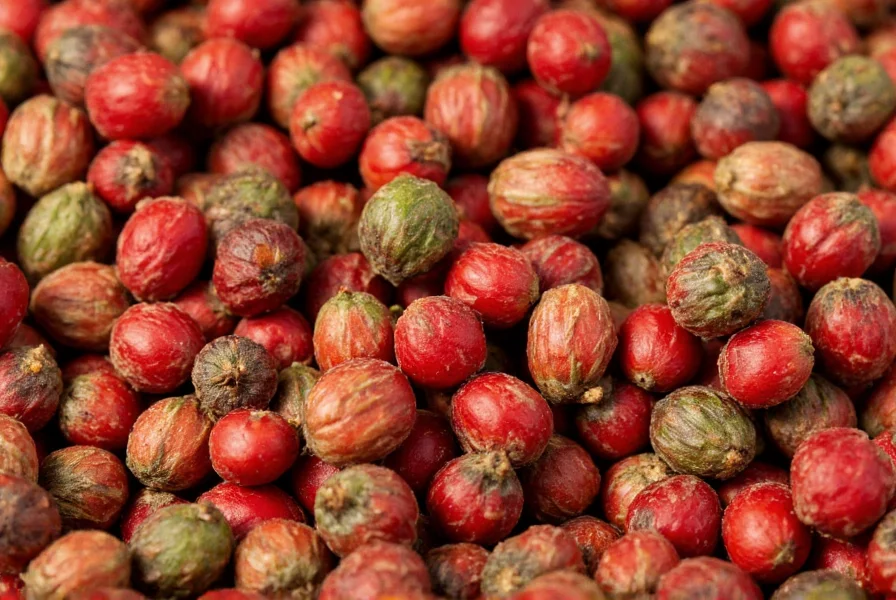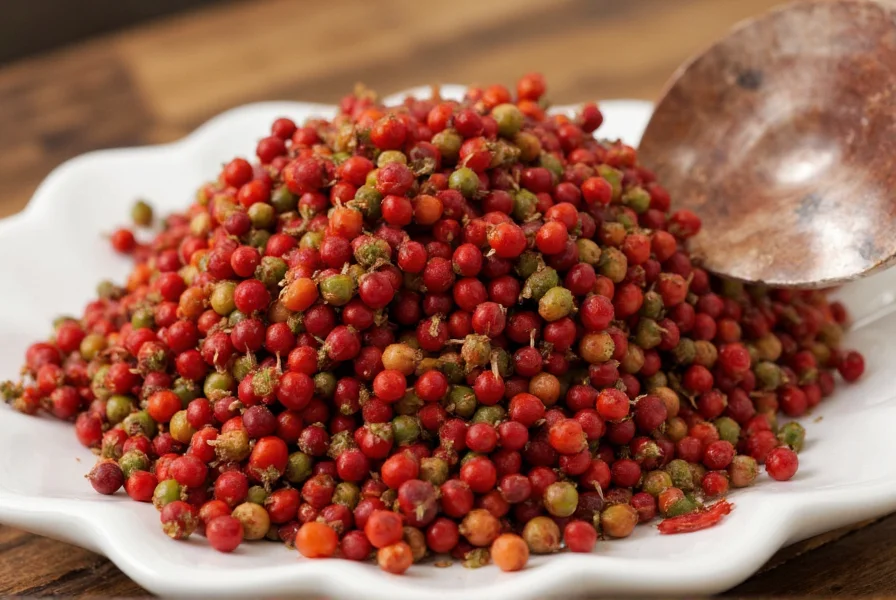Szechuan pepper has captivated palates worldwide with its remarkable sensory experience that goes beyond simple flavor. Unlike conventional peppers that deliver heat through capsaicin, Szechuan pepper contains hydroxy-alpha sanshool, a compound that stimulates nerve endings to create that signature tingling sensation known as 'ma' in Chinese culinary tradition. This unique characteristic makes it an essential component in authentic Sichuan cuisine, where it's often paired with chili peppers to create the famous 'ma la' (numbing and spicy) flavor profile.
What Exactly Is Szechuan Pepper?
Despite its name, Szechuan pepper belongs to the citrus family Rutaceae, not the Piperaceae family that includes black and white pepper. The spice comes from the outer husk or pericarp of berries produced by various Zanthoxylum species. When ripe, these small red berries burst open to reveal black seeds inside, but it's the red husk that's harvested, dried, and used as the spice.
Two primary varieties dominate the market:
- Red Szechuan pepper (Zanthoxylum bungeanum) - The traditional variety with a warm, woody aroma and pronounced numbing effect
- Green Szechuan pepper (Zanthoxylum schinifolium) - A more recent introduction with brighter citrus notes and a faster-acting, more intense numbing sensation
| Variety | Flavor Profile | Numbing Intensity | Best Uses |
|---|---|---|---|
| Red Szechuan pepper | Woody, warm, slightly floral | Moderate, longer-lasting | Classic Sichuan dishes, five-spice powder |
| Green Szechuan pepper | Bright citrus, herbal | Intense, immediate | Fish dishes, lighter sauces, modern fusion cuisine |
The Science Behind the Signature Tingling Sensation
The distinctive numbing effect of Szechuan pepper results from hydroxy-alpha sanshool, which activates specific mechanoreceptors in your mouth. Rather than triggering pain receptors like capsaicin in chili peppers, sanshool creates a vibration-like sensation at approximately 50 hertz, similar to the feeling of touching a low-voltage electrical current. This unique sensory experience temporarily alters your perception of other flavors, making it a powerful tool in culinary composition.
Researchers at University College London discovered that Szechuan pepper's tingling effect operates at a frequency that falls between our sense of touch and vibration, explaining why the sensation feels simultaneously familiar yet unusual. This scientific understanding helps explain why Szechuan pepper works so well in balancing rich, fatty dishes—it literally changes how we perceive texture and flavor.
How to Properly Use Szechuan Pepper in Cooking
Mastering Szechuan pepper requires understanding its optimal usage techniques. Unlike many spices, it benefits from careful preparation to maximize flavor while minimizing unwanted bitterness:
- Dry toasting: Lightly toast whole peppercorns in a dry pan over medium-low heat for 1-2 minutes until fragrant. This enhances the citrus notes while reducing any mustiness.
- Grinding technique: Use a dedicated spice grinder or mortar and pestle. Avoid over-grinding, as the essential oils can turn bitter. Many chefs prefer to grind just before use for maximum aroma.
- Timing matters: Add ground Szechuan pepper toward the end of cooking to preserve its volatile aromatic compounds. For whole peppercorns, add them early to infuse oils but remove before serving.
- Bloom in oil: For authentic Sichuan dishes, heat whole peppercorns in oil first to extract their essence before adding other ingredients.
When working with Szechuan pepper, remember that a little goes a long way. The numbing effect accumulates, so start with smaller amounts than you might expect. For most dishes, 1/4 to 1/2 teaspoon of freshly ground Szechuan pepper per serving provides the ideal balance without overwhelming other flavors.

Storage Tips for Maximum Freshness
Szechuan pepper's volatile oils begin degrading soon after grinding, so proper storage significantly impacts quality. Whole peppercorns maintain their potency for 1-2 years when stored correctly, while ground pepper loses flavor within weeks.
Follow these storage guidelines:
- Store whole peppercorns in an airtight container away from light and heat
- Consider refrigeration in humid climates to prevent moisture absorption
- Freeze for long-term storage (up to 2 years) in vacuum-sealed bags
- Grind only what you need for immediate use
- Check freshness by rubbing a few peppercorns between your fingers—fresh ones should release a citrusy aroma
Traditional and Modern Culinary Applications
Szechuan pepper shines in both traditional Chinese dishes and innovative fusion cuisine. In authentic Sichuan cooking, it appears in classics like:
- Mala hot pot (the foundation of the 'ma la' flavor profile)
- Kung Pao chicken
- Dry-fried green beans
- Sichuan-style mapo tofu
- Five-spice powder (where it replaces or complements star anise)
Chefs worldwide now incorporate Szechuan pepper into unexpected applications:
- Chocolate desserts (the numbing effect enhances cocoa's complexity)
- Cocktails (particularly with citrus-forward recipes)
- Seafood preparations (green Szechuan pepper complements fish beautifully)
- Infused oils and vinegars
- Spice rubs for meats beyond traditional applications
Finding Quality Szechuan Pepper
Not all Szechuan pepper is created equal. When selecting, look for:
- Bright red or green color (dull, brownish hues indicate age)
- Intact husks without excessive seeds (seeds can be bitter)
- A pronounced citrus aroma when crushed
- Minimal twig fragments or other debris
Be aware that some products labeled as Szechuan pepper may actually contain adulterated blends or inferior substitutes. Authentic Szechuan pepper should produce that distinctive tingling sensation within seconds of tasting. If you don't experience this characteristic 'ma' effect, the product may be old, low quality, or mislabeled.

Szechuan Pepper Substitutes and Alternatives
When authentic Szechuan pepper isn't available, several alternatives can approximate aspects of its flavor profile, though none perfectly replicate the unique numbing sensation:
- Timut pepper: A Nepalese variety of Zanthoxylum with similar citrus notes and mild numbing effect
- Grains of paradise: Offers citrus and floral notes but lacks the numbing quality
- Black pepper + lemon zest: Combines heat with citrus but misses the signature 'ma' sensation
- Asian prickly ash: Closely related species with similar properties
For authentic Sichuan dishes, substitutes only partially compensate for the absence of true Szechuan pepper. The numbing sensation is integral to the culinary experience, not merely a flavor component. When substituting, adjust expectations and recipes accordingly.
Health Considerations and Culinary Safety
Szechuan pepper contains beneficial compounds including antioxidants and anti-inflammatory agents. Traditional Chinese medicine has used it for digestive issues and toothaches. However, these potential benefits shouldn't be overstated—Szechuan pepper is primarily a culinary ingredient, not a medicinal treatment.
Some individuals may experience mild allergic reactions or heightened sensitivity to the numbing compounds. Start with small amounts if trying Szechuan pepper for the first time. The numbing effect can temporarily alter your ability to judge food temperature, so exercise caution with hot dishes.
Frequently Asked Questions
Is Szechuan pepper actually related to black pepper?
No, Szechuan pepper isn't related to black pepper. It comes from Zanthoxylum plants in the citrus family, while black pepper comes from Piper nigrum in a completely different plant family. The name 'pepper' was applied historically due to superficial similarities in usage, not botanical relationship.
Why does Szechuan pepper make your mouth tingle?
Szechuan pepper contains hydroxy-alpha sanshool, a compound that stimulates specific nerve receptors in your mouth. This creates a vibration-like sensation at approximately 50 hertz, which your brain interprets as tingling or numbing. Unlike chili heat, this sensation doesn't trigger pain receptors but rather affects touch perception.
How should I store Szechuan pepper to maintain freshness?
Store whole Szechuan peppercorns in an airtight container away from light and heat. For maximum freshness, keep them in the refrigerator or freezer. Whole peppercorns maintain potency for 1-2 years when properly stored, while ground pepper loses flavor within weeks. Always grind just before use for best results.
What's the difference between red and green Szechuan pepper?
Red Szechuan pepper (Zanthoxylum bungeanum) has warm, woody notes with moderate numbing that lasts longer. Green Szechuan pepper (Zanthoxylum schinifolium) offers brighter citrus flavors with a more intense, immediate numbing sensation. Green variety works better with fish and lighter dishes, while red is traditional for classic Sichuan meat dishes.
Can I use Szechuan pepper in non-Asian dishes?
Yes, creative chefs use Szechuan pepper in diverse applications beyond traditional Asian cuisine. It works well in chocolate desserts (enhancing cocoa complexity), citrus-based cocktails, spice rubs for meats, and even in some cheese pairings. Start with small amounts as the numbing effect can be surprising in unfamiliar contexts.











 浙公网安备
33010002000092号
浙公网安备
33010002000092号 浙B2-20120091-4
浙B2-20120091-4